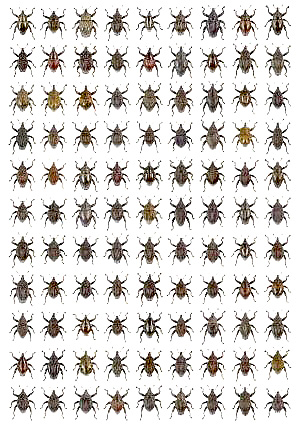
|

|



|
|

|

|
A.Riedel, R.Tanzler, M.Balke, C.Rahmadi, Y.R.Suhardjono. 2014.
Ninety-eight new species of Trigonopterus weevils from Sundaland and the Lesser Sunda Islands.
ZooKeys, 2014, 467: 1-162. DOI: 10.3897/zookeys.467.8206
Abstract
The genus Trigonopterus Fauvel, 1862 is highly diverse in Melanesia.
Only one species, Trigonopterus amphoralis Marshall, 1925 was so far recorded
West of Wallace's Line (Eastern Sumatra). Based on focused field-work the
fauna from Sundaland (Sumatra, Java, Bali, Palawan) and the Lesser Sunda
Islands (Lombok, Sumbawa, Flores) is here revised. We redescribe T. amphoralis
Marshall and describe an additional 98 new species: T. acuminatus sp. n.,
T. aeneomicans sp. n., T. alaspurwensis sp. n., T. allopatricus sp. n.,
T. allotopus sp. n., T. angulicollis sp. n., T. argopurensis sp. n.,
T. arjunensis sp. n., T. asper sp. n., T. attenboroughi sp. n.,
T. baliensis sp. n., T. batukarensis sp. n., T. bawangensis sp. n.,
T. binodulus sp. n., T. bornensis sp. n., T. cahyoi sp. n.,
T. costipennis sp. n., T. cuprescens sp. n., T. cupreus sp. n.,
T. dacrycarpi sp. n., T. delapan sp. n., T. dentipes sp. n.,
T. diengensis sp. n., T. dimorphus sp. n., T. disruptus sp. n., T. dua sp. n.,
T. duabelas sp. n., T. echinatus sp. n., T. empat sp. n., T. enam sp. n.,
T. fissitarsis sp. n., T. florensis sp. n., T. foveatus sp. n.,
T. fulgidus sp. n., T. gedensis sp. n., T. halimunensis sp. n.,
T. honjensis sp. n., T. ijensis sp. n., T. javensis sp. n.,
T. kalimantanensis sp. n., T. kintamanensis sp. n., T. klatakanensis sp. n.,
T. lampungensis sp. n., T. latipes sp. n., T. lima sp. n.,
T. lombokensis sp. n., T. merubetirensis sp. n., T. mesehensis sp. n.,
T. micans sp. n., T. misellus sp. n., T. palawanensis sp. n.,
T. pangandaranensis sp. n., T. paraflorensis sp. n., T. pararugosus sp. n.,
T. parasumbawensis sp. n., T. pauxillus sp. n., T. payungensis sp. n.,
T. porcatus sp. n., T. pseudoflorensis sp. n., T. pseudosumbawensis sp. n.,
T. punctatoseriatus sp. n., T. ranakensis sp. n., T. relictus sp. n.,
T. rinjaniensis sp. n., T. roensis sp. n., T. rugosostriatus sp. n.,
T. rugosus sp. n., T. rutengensis sp. n., T. saltator sp. n.,
T. santubongensis sp. n., T. sasak sp. n., T. satu sp. n., T. schulzi sp. n.,
T. sebelas sp. n., T. sembilan sp. n., T. sepuluh sp. n., T. seriatus sp. n.,
T. serratifemur sp. n., T. setifer sp. n., T. silvestris sp. n.,
T. singkawangensis sp. n., T. singularis sp. n., T. sinuatus sp. n.,
T. squalidus sp. n., T. sumatrensis sp. n., T. sumbawensis sp. n.,
T. sundaicus sp. n., T. suturalis sp. n., T. syarbis sp. n.,
T. telagensis sp. n., T. tepalensis sp. n., T. tiga sp. n.,
T. trigonopterus sp. n., T. tujuh sp. n., T. ujungkulonensis sp. n.,
T. variolosus sp. n., T. vulcanicus sp. n., T. wallacei sp. n..
All new species are authored by the taxonomist-in-charge, Alexander Riedel.
Most species belong to the litter fauna of primary wet evergreen forests.
This habitat has become highly fragmented in the study area and many of its
remnants harbor endemic species. Conservation measures should be intensified,
especially in smaller and less famous sites to minimize the number of species
threatened by extinction.